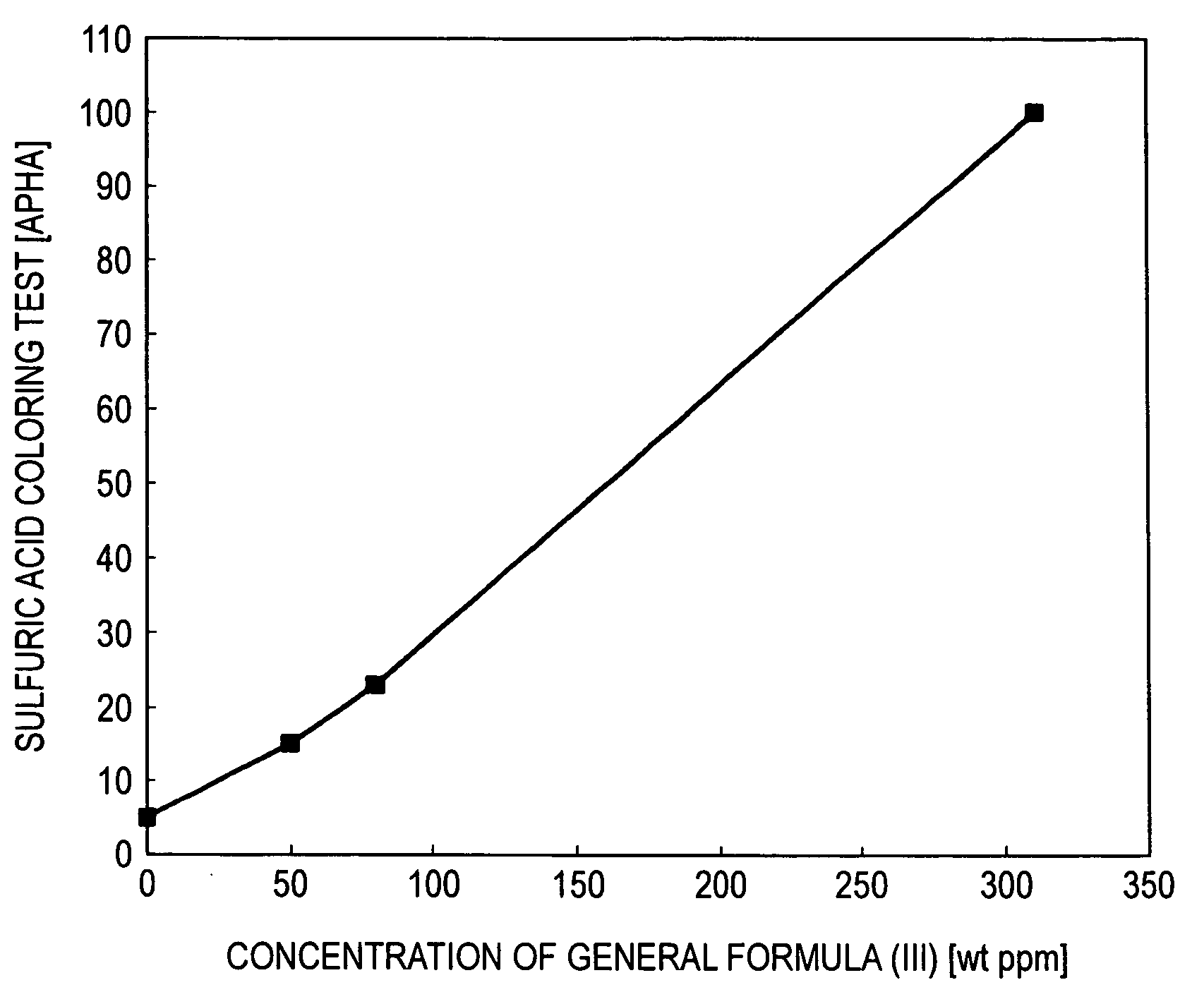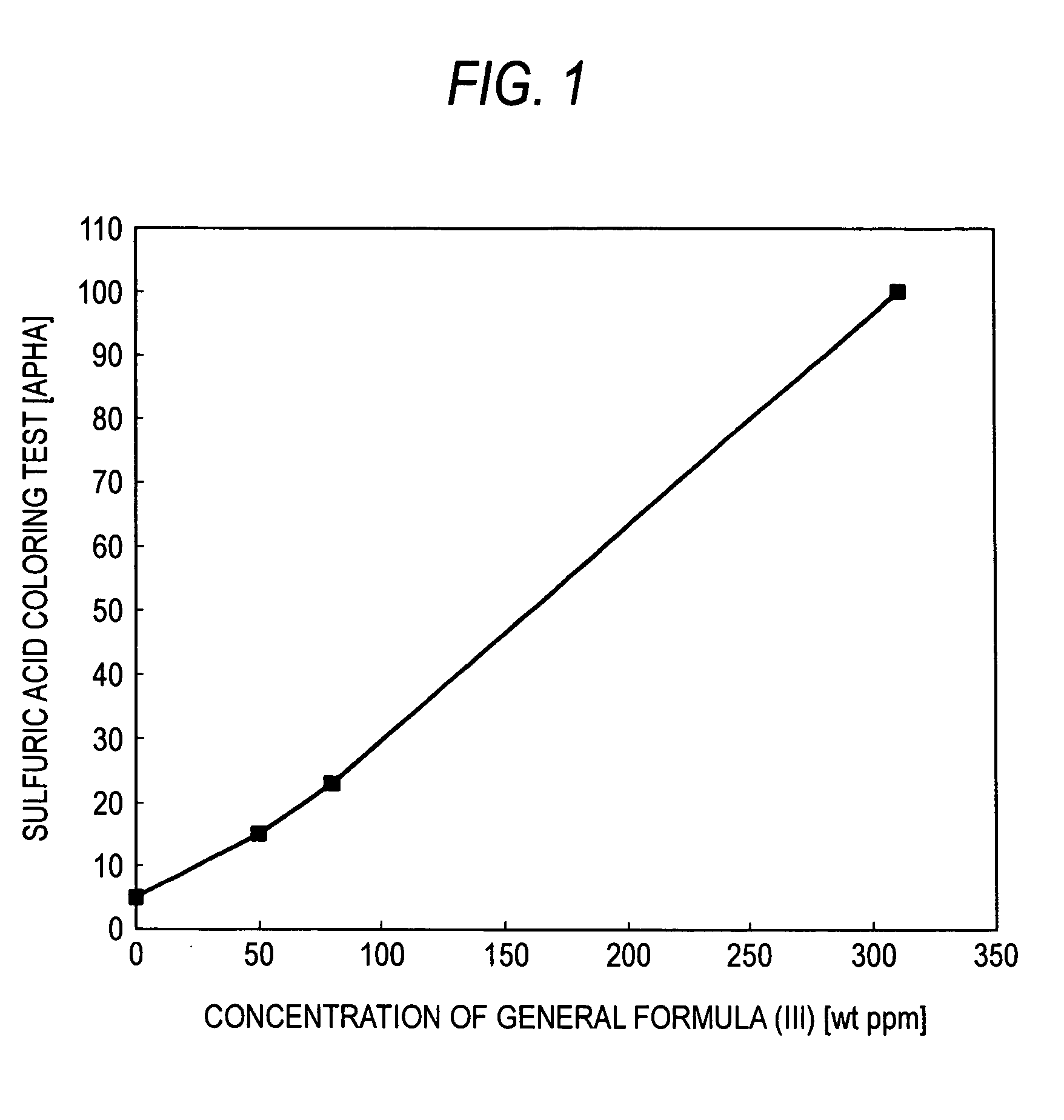Process for Production of Purified Alcohols
a technology of purified alcohol and process, which is applied in the preparation of carbonyl compounds, oxygen-containing compounds, organic chemistry, etc., can solve the problems of sulfuric acid coloring test, 2eh to give unfavorable results,
- Summary
- Abstract
- Description
- Claims
- Application Information
AI Technical Summary
Benefits of technology
Problems solved by technology
Method used
Image
Examples
example 1
[0044]Normal butyraldehyde was mixed with 2 wt % aqueous sodium hydroxide solution and reacted at 90° C. The liquid reaction mixture was allowed to stand and separate into layers to thereby obtain 2-ethylhexenal.
[0045]The 2-ethylhexenal obtained was distilled with a distiller having 10 Oldshue plates under the conditions of a column top pressure of 200 mmHg and a reflux ratio of 0.23 to remove 99% of the high-boiling compounds. This 2-ethylhexenal from which high-boiling compounds had been removed was subjected to liquid-phase hydrogenation at a temperature of 120° C. and a pressure of 4.0 MPa in the presence of an Ni—Cr catalyst to thereby obtain crude 2EH. This crude 2EH contained 8 weight ppm dihydropyran compound and 0 weight ppm pyran compound.
[0046]This crude 2EH was distilled with a distiller having 35 Oldshue plates under the conditions of a column top pressure of 100 mmHg and a reflux ratio of 7 to thereby remove low-boiling ingredients from the crude 2EH. The crude 2EH was...
example 2
[0047]The crude 2EH obtained in Example 1 was distilled to obtain purified 2EH having a dihydropyran compound concentration of 0 weight ppm and a pyran compound concentration of 0 weight ppm. The dihydropyran compound represented by general formula (III) was added to this purified 2EH in various concentrations. The resultant solutions were subjected to the sulfuric acid coloring test. The results obtained are shown in Table 1.
TABLE 1Table 1Concentration ofgeneral formula (IV) in 2EHSulfuric acid coloring test(weight ppm)(APHA)0550158023310100
[0048]FIG. 1 was drawn from the results given in Table 1. When this figure is used, the results of the sulfuric acid coloring test can be determined from the concentration of the compound of general formula (III) in the 2EH.
example 3
[0049]Normal butyraldehyde was mixed with 2 wt % aqueous sodium hydroxide solution and reacted at 90° C. The liquid reaction mixture was allowed to stand and separate into layers to thereby obtain 2-ethylhexenal.
[0050]The 2-ethylhexenal obtained was subjected to vapor-phase hydrogenation at a temperature of 190° C. and a pressure of 0.45 MPa in the presence of a Cu—Cr—Mn—Ba—Ni catalyst (nickel content, 1%) to react about 90% of the 2-ethylhexenal.
[0051]This liquid hydrogenation reaction mixture was vaporized and fed, together with hydrogen gas, to a fixed-bed reactor packed with an Ni—Zr catalyst. The feed temperature was regulated so that the temperature as measured at a place located in the ¾ position from the inlet of the catalyst layer became 140° C. Vapor-phase hydrogenation was conducted at a pressure of 0.45 MPa. This reaction was conducted while supplying the feed material at such a rate that the gas space velocity (GHSV) as measured in the catalyst layer after the ¾ positio...
PUM
| Property | Measurement | Unit |
|---|---|---|
| pressure | aaaaa | aaaaa |
| temperature | aaaaa | aaaaa |
| pressure | aaaaa | aaaaa |
Abstract
Description
Claims
Application Information
 Login to View More
Login to View More - R&D
- Intellectual Property
- Life Sciences
- Materials
- Tech Scout
- Unparalleled Data Quality
- Higher Quality Content
- 60% Fewer Hallucinations
Browse by: Latest US Patents, China's latest patents, Technical Efficacy Thesaurus, Application Domain, Technology Topic, Popular Technical Reports.
© 2025 PatSnap. All rights reserved.Legal|Privacy policy|Modern Slavery Act Transparency Statement|Sitemap|About US| Contact US: help@patsnap.com



